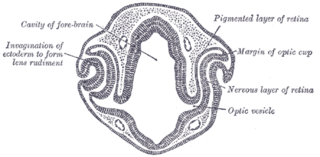Related Research Articles

The retina is the innermost, light-sensitive layer of tissue of the eye of most vertebrates and some molluscs. The optics of the eye create a focused two-dimensional image of the visual world on the retina, which then processes that image within the retina and sends nerve impulses along the optic nerve to the visual cortex to create visual perception. The retina serves a function which is in many ways analogous to that of the film or image sensor in a camera.

Macular degeneration, also known as age-related macular degeneration, is a medical condition which may result in blurred or no vision in the center of the visual field. Early on there are often no symptoms. Over time, however, some people experience a gradual worsening of vision that may affect one or both eyes. While it does not result in complete blindness, loss of central vision can make it hard to recognize faces, drive, read, or perform other activities of daily life. Visual hallucinations may also occur.

Lipofuscin is the name given to fine yellow-brown pigment granules composed of lipid-containing residues of lysosomal digestion. It is considered to be one of the aging or "wear-and-tear" pigments, found in the liver, kidney, heart muscle, retina, adrenals, nerve cells, and ganglion cells.

A cone dystrophy is an inherited ocular disorder characterized by the loss of cone cells, the photoreceptors responsible for both central and color vision.

Drusen, from the German word for node or geode, are tiny yellow or white accumulations of extracellular material that build up between Bruch's membrane and the retinal pigment epithelium of the eye. The presence of a few small ("hard") drusen is normal with advancing age, and most people over 40 have some hard drusen. However, the presence of larger and more numerous drusen in the macula is a common early sign of age-related macular degeneration (AMD).

Vitelliform macular dystrophy is an irregular autosomal dominant eye disorder which can cause progressive vision loss. This disorder affects the retina, specifically cells in a small area near the center of the retina called the macula. The macula is responsible for sharp central vision, which is needed for detailed tasks such as reading, driving, and recognizing faces. The condition is characterized by yellow, slightly elevated, round structures similar to the yolk of an egg.
Stargardt disease is the most common inherited single-gene retinal disease. In terms of the first description of the disease, it follows an autosomal recessive inheritance pattern, which has been later linked to bi-allelic ABCA4 gene variants (STGD1). However, there are Stargardt-like diseases with mimicking phenotypes that are referred to as STGD3 and STGD4, and have a autosomal dominant inheritance due to defects with ELOVL4 or PROM1 genes, respectively. It is characterized by macular degeneration that begins in childhood, adolescence or adulthood, resulting in progressive loss of vision.

Eye formation in the human embryo begins at approximately three weeks into embryonic development and continues through the tenth week. Cells from both the mesodermal and the ectodermal tissues contribute to the formation of the eye. Specifically, the eye is derived from the neuroepithelium, surface ectoderm, and the extracellular mesenchyme which consists of both the neural crest and mesoderm.
Astellas Institute for Regenerative Medicine is a subsidiary of Astellas Pharma located in Marlborough, Massachusetts, US, developing stem cell therapies with a focus on diseases that cause blindness. It was formed in 1994 as a company named Advanced Cell Technology, Incorporated (ACT), which was renamed to Ocata Therapeutics in November 2014. In February 2016 Ocata was acquired by Astellas for $379 million USD.

Pigment epithelium-derived factor (PEDF) also known as serpin F1 (SERPINF1), is a multifunctional secreted protein that has anti-angiogenic, anti-tumorigenic, and neurotrophic functions. Found in vertebrates, this 50 kDa protein is being researched as a therapeutic candidate for treatment of such conditions as choroidal neovascularization, heart disease, and cancer. In humans, pigment epithelium-derived factor is encoded by the SERPINF1 gene.

Bestrophin-1 (Best1) is a protein that, in humans, is encoded by the BEST1 gene.

Homeobox protein OTX2 is a protein that in humans is encoded by the OTX2 gene.

A maculopathy is any pathological condition of the macula, an area at the centre of the retina that is associated with highly sensitive, accurate vision.

Ocular albinism type 1(OA1) is the most common type of ocular albinism, with a prevalence rate of 1:50,000. It is an inheritable classical Mendelian type X-linked recessive disorder wherein the retinal pigment epithelium lacks pigment while hair and skin appear normal. Since it is usually an X-linked disorder, it occurs mostly in males, while females are carriers unless they are homozygous. About 60 missense and nonsense mutations, insertions, and deletions have been identified in Oa1. Mutations in OA1 have been linked to defective glycosylation and thus improper intracellular transportation.

Macular telangiectasia is a condition of the retina, the light-sensing tissue at the back of the eye that causes gradual deterioration of central vision, interfering with tasks such as reading and driving.
Retinal gene therapy holds a promise in treating different forms of non-inherited and inherited blindness.

Lineage Cell Therapeutics, Inc. is a clinical-stage biotechnology company developing novel cell therapies for unmet medical needs. Lineage’s programs are based on its robust proprietary cell-based therapy platform and associated in-house development and manufacturing capabilities. With this platform Lineage develops and manufactures specialized, terminally differentiated human cells from its pluripotent and progenitor cell starting materials. These differentiated cells are developed to either replace or support cells that are dysfunctional or absent due to degenerative disease or traumatic injury or administered as a means of helping the body mount an effective immune response to cancer.

Emixustat is a small molecule notable for its establishment of a new class of compounds known as visual cycle modulators (VCMs). Formulated as the hydrochloride salt, emixustat hydrochloride, it is the first synthetic medicinal compound shown to affect retinal disease processes when taken by mouth. Emixustat was invented by the British-American chemist, Ian L. Scott, and is currently in Phase 3 trials for dry, age-related macular degeneration (AMD).

Stem cell therapy for macular degeneration is the use of stem cells to heal, replace dead or damaged cells of the macula in the retina. Stem cell based therapies using bone marrow stem cells as well as retinal pigment epithelial transplantation are being studied. A number of trials have occurred in humans with encouraging results.
References
- 1 2 3 "Prof. Ruth Ashery Padan | Faculty of Medicine". en-med.tau.ac.il. Retrieved 2024-05-16.
- ↑ "Ruth Ashery-Padan is the new Head of the Yoran Institute for Human Genome Research". en-med.tau.ac.il. Retrieved 2024-05-16.
- 1 2 3 4 "Ruth Ashery-Padan, PhD, Tel Aviv University | E. Matilda Ziegler Foundation for the Blind" . Retrieved 2024-05-16.
- ↑ "Ruth Ashery Padan". Tel Aviv University. Retrieved 2024-05-16.
- ↑ "Ruth Ashery Padan". ResearchGate.
- 1 2 Cohen-Gulkar, Mazal; David, Ahuvit; Messika-Gold, Naama; Eshel, Mai; Ovadia, Shai; Zuk-Bar, Nitay; Idelson, Maria; Cohen-Tayar, Yamit; Reubinoff, Benjamin; Ziv, Tamar; Shamay, Meir; Elkon, Ran; Ashery-Padan, Ruth (2023-01-17). "The LHX2-OTX2 transcriptional regulatory module controls retinal pigmented epithelium differentiation and underlies genetic risk for age-related macular degeneration". PLOS Biology. 21 (1): e3001924. doi: 10.1371/journal.pbio.3001924 . ISSN 1545-7885. PMC 9844853 . PMID 36649236.
- 1 2 "Researchers Identify A New Genetic Risk Factor for Age-related Eye Disease". Tel Aviv University. 2023-02-07. Retrieved 2024-05-31.
- ↑ "Dan David Prize". Dan David Prize. Retrieved 2024-05-16.
- ↑ "Teva Pharmaceutical Industries Ltd". www.tevapharm.com. Retrieved 2024-05-31.
- ↑ "E. Matilda Ziegler Foundation for the Blind | An Innovative Approach To Vision Research" . Retrieved 2024-05-16.
- ↑ "Scholarships for the Integration of Outstanding Faculty". המועצ. 2019-04-12. Retrieved 2024-05-16.
This article needs additional or more specific categories .(June 2024) |